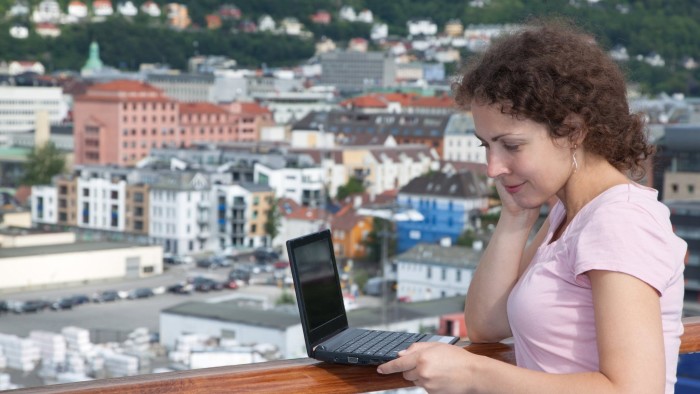Occupational health: how employers can learn from Nordic countries

Roula Khalaf, Editor of the FT, selects her favourite stories in this weekly newsletter.
At Danish biotechnology company Novozymes, employees from different regions and functions are encouraged to exchange ideas on health and safety that can help avoid accidents. As such, the company’s Lessons Learned Sharing (LLS) programme is an example of what some say gives Nordic countries a lead in occupational health — a willingness to collaborate.
“It’s really important to have extensive collaboration between management and employees and to understand their experiences and needs,” says Marianne Frydendahl, vice-president for quality, environment and safety at Novozymes.
A number of policy and cultural factors lie behind the approach of Nordic organisations to health in the workplace. For a start, these countries are at the forefront of establishing acceptable patterns of work-life balance.
On the Organisation for Economic Co-operation and Development’s Better Life Index, Nordic countries perform well, with Denmark topping the list. Just 2 per cent of Danish employees work very long hours, compared to the OECD average of 13 per cent. In Sweden, the figure is just 1 per cent.
“It also has to do with general living standards,” says Eirik Bjerkebaek, corporate head of health and working environment at Statoil, the Norwegian energy group. “People have the resources to take care of their health and they expect business to be part of that as well.”
The region’s policymakers play an important role in promoting occupational health. Mr Bjerkebaek cites Norway’s working environment act of 1977, legislation that is revised regularly in collaboration with the main political parties, employers and employee organisations.
And rather than policing and punishing, he says that the response to any regulatory breaches is usually “to work with unions and other representatives and look at it as an improvement opportunity”.
For some, engaging employees is an important part of health and safety strategies. At Novozymes, for instance, the LLS programme — which was created in 2014 to build on existing programmes following the company’s 2013 global safety assessment — is run by co-ordinators in each region in which the company has operations.
In addition, in line with Danish practice, the Novozymes workforce elects employees to its health and safety committee, says Ms Frydendahl. These representatives play a role in promoting and monitoring everything from safety to work-life balance, healthy lifestyle habits, improved nutrition and exercise.
Similarly, at Statoil, employee-appointed delegates work with managers and the leaders of business units on health, safety and the working environment — a practice enshrined in Norwegian legislation.
“And we’ve been increasing the value of having this function,” says Mr Bjerkebaek. This, he says, includes having delegates involved in developing the company’s annual employee work environment survey.
“We engage with the safety representatives interpreting the results and finding the right actions,” he says. “And we involve safety delegates systematically in any risk analysis we do of organisational change.”
Antti Koivula, director-general Finnish Institute for Occupational Health (FIOH), sees this spirit of co-operation at work broadly across the region’s corporate sector. “Collaboration has traditionally been relatively rich and easy,” he says. “Management is close to employees — and that’s built into our society and culture.”
While companies such as Novozymes and Statoil are tapping into their internal networks to promote workplace health, other organisations based in the Nordic countries are promoting the same principle more broadly.
Denmark, for example, is home to the Relations Network, which was established in 2014. The network hosts meetings and conferences and promotes knowledge sharing to help its members develop policies and programmes that address health, wellbeing and stress.
Meanwhile, Nordic companies can tap into the support of academic bodies such as the FIOH or Norway’s National Institute of Occupational Health, many of which receive government funding.
Funded by the Nordic Council of Ministers, the Nordic Institute for Advanced Training in Occupational Health (NIVA) uses research findings to develop courses and seminars for both researchers and practitioners.
NIVA courses and workshops range from topics such as occupation health and safety in agriculture and horticulture to risk factors for accidents and poor health among young workers and the links between mental health, work satisfaction, cardiovascular and metabolic disorders and workplace stress.
In common with counterparts in other countries, however, not all Nordic companies can provide hard evidence for the financial return on investment in health and safety measures. “Companies don’t often openly discuss it,” says Prof Koivula.
Beyond tracking the cost of sickness and absenteeism, return on investment in health is something with which companies worldwide continue to struggle, particularly when it comes to stress and mental health.
“It’s hard to measure because it’s embedded everywhere,” says Prof Koivula. “So there’s room to create better tools and measures to calculate the return on investment.”
Even so, companies recognise the benefits. “We do this because we believe it’s the right thing to do and it motivates and engages employees,” says Ms Frydendahl.
Prof Koivula agrees. “You just have to do it to be competitive,” he says.
Comments